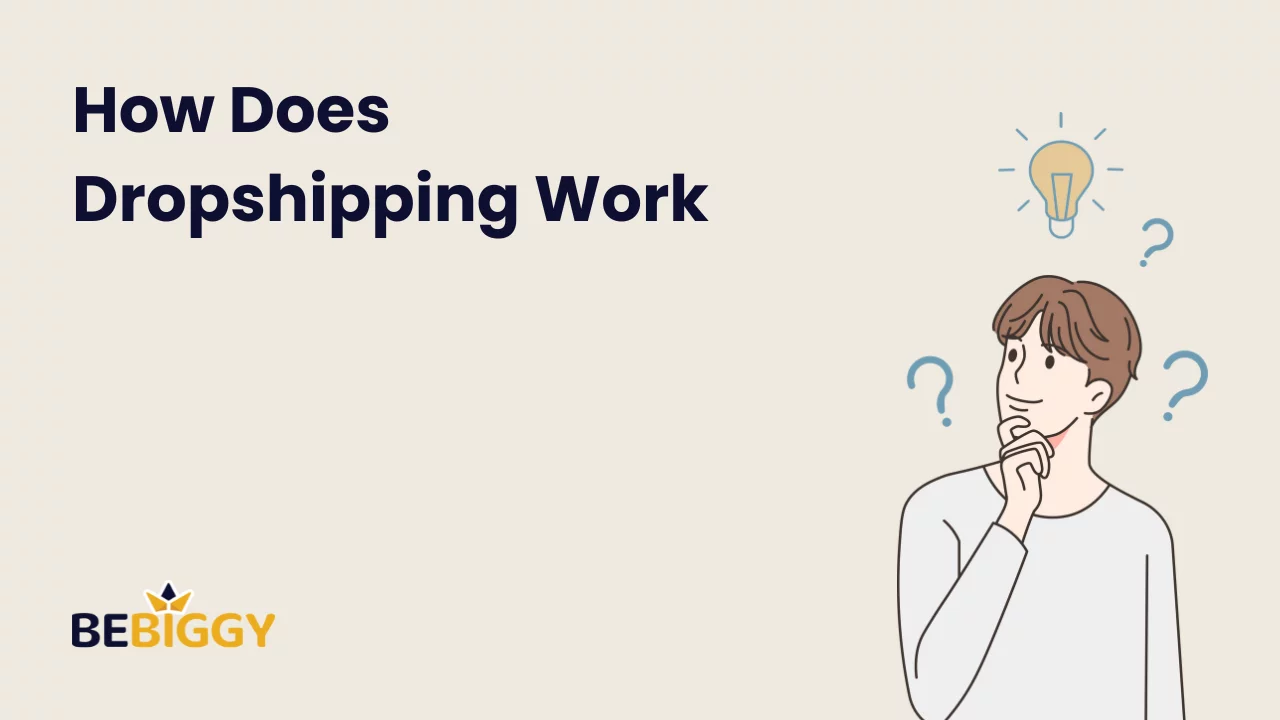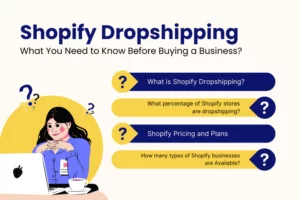How Does Dropshipping Work: A Comprehensive Guide to the Dropshipping Process
Are you ready to unlock the secrets of a thriving online business that’s taking the e-commerce world by storm? Brace yourself for an exhilarating journey through the realm of dropshipping, where innovation meets entrepreneurship.
Picture a venture that allows you to scale without borders, capitalize on global trends, and reap the rewards of a low-risk, high-reward business model. That’s the magic of dropshipping. In this blog, we’ll dive into the core concepts of dropshipping, from the mechanics to the mind-blowing potential it offers. You’ll discover how entrepreneurs worldwide are turning their dreams into reality, one dropshipping success story at a time. So, fasten your seatbelts because the world of dropshipping is about to unfold before your eyes.
What is Dropshipping?
Dropshipping stands as a business model that provides entrepreneurs with the opportunity to market and sell products through online platforms, all while sidestepping the need to maintain any physical inventory. In simpler terms, it’s an e-commerce approach that eliminates the complexities and challenges associated with warehousing. Now, let’s explore the process in more detail.
Examining Shopify’s E-Commerce Dominance

The Leading E-Commerce Platform: Shopify boasts a remarkable status as the world’s most popular e-commerce platform, serving over 2 million online stores.
Dropshipping on Shopify: Dropshipping constitutes approximately 7% of all sales on Shopify.
Market Share: Shopify holds a significant share of the e-commerce platform market, with millions of businesses choosing the platform for their online stores globally.
User-Friendly Interface: Shopify’s intuitive and user-friendly interface makes it accessible to entrepreneurs with varying levels of technical expertise, contributing to its widespread adoption.
Versatile Store Customization: The platform offers various customizable templates and themes, allowing businesses to create unique and visually appealing online storefronts.
App Ecosystem: Shopify’s extensive app ecosystem provides additional functionalities, from marketing tools to inventory management, enhancing the overall capabilities of e-commerce stores.
Payment Integration: Shopify seamlessly integrates with various payment gateways, offering flexibility to businesses in accepting payments, including major credit cards and alternative methods.
Mobile Responsiveness: With a focus on mobile responsiveness, Shopify ensures a consistent and optimized shopping experience across devices, catering to the growing trend of mobile commerce.
Scalability: Shopify accommodates businesses of all sizes, from startups to enterprise-level, with scalable plans and features that can grow with the evolving needs of an online store.
Robust Security Measures: Shopify prioritizes the security of online transactions, providing SSL encryption, secure payment options, and compliance with industry standards to instil trust among consumers.
Seamless Integration with Third-Party Services: Shopify easily integrates with various third-party services, facilitating smooth operations, whether it’s shipping, marketing, or customer relationship management.
Shopify Plus for Enterprise: For large-scale enterprises, Shopify Plus offers advanced features, dedicated support, and a scalable infrastructure tailored to meet the demands of high-volume businesses.
Global Presence: Shopify enables businesses to reach a global audience by supporting multiple currencies and languages, making it a preferred choice for international expansion.
E-commerce Education and Support: Shopify provides a wealth of educational resources and customer support, empowering businesses with the knowledge and assistance needed to thrive in the competitive e-commerce landscape.
How does the cycle of dropshipping work?

- Customer Places an Order: Imagine you’re running an online store, and a customer buys a product from your website. This marks the beginning of the dropshipping process.
- You Relay the Order: Instead of having the product in your possession, you send the customer’s order and shipping details to a third-party supplier, which can be a manufacturer, wholesaler, or another retailer. They have the product you’re selling.
- Supplier Ships Directly to Customer: Now, it’s the supplier’s turn. They pack and ship the product directly to your customer. You’re like the conductor orchestrating this entire operation, but you need to handle the product physically.
The Benefits of Dropshipping:

- Low Startup Costs: Dropshipping is known for its low barrier to entry. You don’t need to invest in a vast inventory upfront, which significantly reduces your initial capital requirements.
- Minimal Overhead: Without a warehouse to maintain, you don’t have to worry about storage costs, personnel, or managing inventory. This cuts your operational expenses.
- Extensive Product Variety: You can present a diverse array of products without the necessity of holding inventory for each item.
- Location Independence: Dropshipping is an online business, so that you can run it from virtually anywhere with an internet connection. This gives you geographical flexibility.
- Low Risk: Since you only purchase products once you’ve secured a sale, you won’t end up with unsold inventory. This mitigates the financial Risk compared to traditional retail.
- Scalability: With the growth of your business, you can expand rapidly, unhindered by the constraints of traditional warehousing. This means you can diversify your product range and reach a broader customer base as your business flourishes.
How to Start a Dropshipping Business:

- Choose a Niche: Select a niche or industry that interests you and has a demand for products. Research your competitors and target audience.
- Market Research: Identify profitable products within your niche. Look for items with reasonable demand and competition. Tools like Google Trends and Amazon Best Sellers can be valuable.
- Find Reliable Suppliers: Research and partner with trustworthy suppliers or wholesalers. Ensure they have a solid track record of fulfilling orders on time and with quality products.
- Create an Online Store: Set up an e-commerce website using platforms like Shopify, WooCommerce, or Magento. Make it user-friendly and visually appealing.
- Product Listings: Add the products you want to sell on your website. Write compelling product descriptions and use high-quality images.
- Marketing and Promotion: Implement marketing strategies to drive traffic to your online store. Utilize social media, content marketing, paid advertising, and SEO.
- Customer Service: Provide excellent customer support, address inquiries promptly, and ensure timely order fulfillment.
- Monitor and Optimize: Regularly analyze your business performance and make adjustments as needed. This might involve tweaking your product selection, pricing, or marketing strategies.
Dropshipping has the potential to be a gratifying online venture when executed effectively. Achieving success in this field relies on comprehensive preparation, diligent research, and a steadfast dedication to meeting customer needs. It presents a route to entrepreneurship that doesn’t necessitate a substantial initial investment in inventory or the establishment of a physical store, rendering it a compelling choice for numerous prospective business proprietors.
Earnings Potential for Shopify Dropshippers

- Average Monthly Earnings: Insights into the typical monthly earnings of Shopify dropshippers, ranging from $50 to $5,000.
- High Achievers: A look at the top 10% of Shopify dropshippers are those who surpass an annual income of $100,000.
How does dropshipping work?
1. Finding a dropshipping supplier
Finding the right dropshipping supplier is crucial to the success of your dropshipping business. You want to partner with reliable suppliers who offer high-quality products, competitive pricing, and efficient shipping and fulfillment processes. There are several ways to find dropshipping suppliers:
- Online directories: Websites like SaleHoo and Worldwide Brands provide lists of verified dropshipping suppliers that you can contact and work with.
- Marketplace platforms: Platforms such as AliExpress, Oberlo, and Wholesale Central connect you with a wide range of suppliers where you can source products for your store.
- Trade exhibitions and professional gatherings: Engaging in trade exhibitions and industry-related conferences within your specific field presents an excellent opportunity to connect with potential suppliers and forge valuable relationships.
2. Placing and fulfilling orders
Once you have set up your online store and connected with dropshipping suppliers, the process of placing and fulfilling orders is relatively straightforward:
- Customer places an order: When a customer purchases your online store, you receive the order details, including the customer’s shipping address and the products they bought.
- Forward order to the supplier: You then forward the order details to your dropshipping supplier, including the customer’s shipping address.
- Product shipment by the supplier: Once the supplier receives the order, they proceed to dispatch the product directly to the customer’s doorstep. They handle the inventory management, packaging, and shipping, saving you the hassle and cost of managing a physical inventory.
- Tracking and customer support: As the merchant, you are responsible for providing tracking information to the customer and handling any customer support inquiries they may have.
The beauty of dropshipping is that you can focus on marketing your products and providing excellent customer service while the suppliers take care of the logistics and inventory management. It’s a low-risk and cost-effective way to start an online business.
Overall, dropshipping allows you to sell products without having to handle inventory or store products.
3. Product Selection for Dropshipping
Selecting the right products for your dropshipping venture is a pivotal factor in ensuring its success. Here are two essential considerations to keep in mind when choosing merchandise for your dropshipping store:
- Identifying Profitable Products: The first step is to pinpoint products with a promising potential for profitability. Extensive market research is critical to recognize which items are currently in high demand and possess the capability to drive sales. Focus on identifying products with a substantial profit margin and limited competition. This strategy ensures that you not only secure a reasonable profit but also establish a unique position in the market.
- Using Google Trends and keyword search: Leverage tools like Google Trends and keyword research platforms to gather data on the popularity and search volume of specific products. Furthermore, seek out products with a robust online presence, positive customer reviews, and a proven track record of successful sales. This information will provide valuable insights into market demand and customer satisfaction related to those products.
4. Establishing an Online Store
Dropshipping has emerged as a favored business model, enabling entrepreneurs to launch their online retail outlets without the complexities of managing inventory and shipping logistics. If you’re contemplating entry into the world of dropshipping, here’s a comprehensive overview of its operational framework.
- Choosing an E-commerce Platform:The inaugural step in commencing your dropshipping enterprise is the selection of an e-commerce platform. Renowned choices encompass platforms like Shopify, WooCommerce, and BigCommerce. These platforms offer indispensable functionalities, such as product cataloging, order management, and payment processing. When determining the ideal venue for your store, evaluate criteria like pricing, user-friendliness, and the available resources.
- Crafting and Enhancing Your Store: Once you’ve settled on your e-commerce platform, the next order of business is designing and enhancing your virtual storefront. This entails the selection of a theme or template that harmonizes with your brand and target audience. Tailor the layout, color schemes, and typography to craft an aesthetically pleasing and user-centric shopping environment.
For search engine optimization (SEO) and an increased likelihood of visibility to potential customers, attend to on-page SEO. This procedure includes optimizing product descriptions, titles, URLs, and meta tags with pertinent keywords.
- Procuring Merchandise and Identifying Suppliers: In the realm of dropshipping, inventory management is not your concern. Instead, you collaborate with suppliers responsible for order fulfillment and direct shipment to your customers. Seek reputable suppliers offering an extensive array of products at competitive price points. Online platforms like AliExpress, Oberlo, and Spocket facilitate seamless connections with trustworthy suppliers.
- Marketing and Fostering Website Traffic: Achieving success in dropshipping hinges on proactive marketing and the cultivation of website traffic. Leverage diverse marketing channels, such as social media advertising, partnerships with influencers, email marketing, and search engine optimization. Construct compelling content and incentives to attract potential customers and motivate them to complete purchases.
- Overseeing Customer Service and Order Execution: As customer orders begin to flow in, prioritize the delivery of exceptional customer service. This encompasses timely response to customer inquiries and concerns, as well as ensuring the prompt fulfillment of orders. Maintain communication with your suppliers to guarantee the punctual shipment of products and manage returns or any issues that may arise.
By adhering to these steps and continually refining your store and marketing strategies, you can establish a prosperous dropshipping venture and create a consistent revenue stream.
Projections for the Dropshipping Market

Anticipated Growth
- Projections for the Shopify dropshipping market’s expansion, with expectations to reach $557.9 billion by 2025.
Long-Term Profitability
- An exploration of the continued profitability of dropshipping, supported by the expected growth of the global dropshipping market, which is on track to achieve $557.9 billion by 2025.
Sustained Momentum
- Insights into the ongoing momentum of the dropshipping market, with projected values of $301.11 billion in 2024 and $372.47 billion in 2025.
5. Marketing and Promoting Your Store
Crafting Effective Marketing Strategies
A pivotal component of a thriving dropshipping business is the execution of effective marketing. Here are some strategies to consider:
- Define your target audience: Building successful marketing campaigns necessitates a profound understanding of your ideal customers. Conduct market research to unveil their demographics, interests, and purchasing habits.
- Establish a distinct brand identity: Forge a robust brand identity that sets your store apart from competitors. Develop an engaging logo, maintain a consistent visual style, and cultivate a unique voice that resonates with your target audience.
- Generate compelling content: Utilize content marketing to attract and retain customers. Craft high-quality blog posts, videos, and social media content that provide value and showcase your expertise.
- Optimize for search engines: Implement search engine optimization (SEO) techniques to heighten your store’s visibility in search engine results. Utilize pertinent keywords, enhance product descriptions, and foster backlinks to bolster your ranking.
Stats:
- According to a study by Oberlo, 47% of dropshippers found social media marketing the most effective way to promote their stores.
- A study by Shopify found that email marketing is the most profitable marketing channel for dropshippers, with an average return on investment (ROI) of 4,400%.
- According to a study by Dropship.com, 63% of dropshippers believe that offering excellent customer service is the most important factor in their success.
Harnessing the Power of Social Media and Influencer Marketing

Social media platforms offer a valuable avenue for connecting with potential customers. Consider the following tactics:
- Select the appropriate platforms:
Identify the social media platforms your target audience frequents and establish a robust presence on those channels. Concentrate your efforts where meaningful engagement with your audience is feasible.
- Craft compelling content:
Devise a social media strategy encompassing a blend of product showcases, lifestyle content, customer testimonials, and behind-the-scenes insights.
- Collaborate with influencers:
Influencer marketing broadens your reach to a broader audience. Identify influencers within your niche who align with your brand and collaborate with them to endorse your products.
- Launch targeted ad campaigns:
Paid social media advertising empowers you to hone in on specific demographics, interests, and behaviors. Develop targeted ad campaigns that spotlight your products and drive traffic to your online store.
By incorporating these marketing strategies and leveraging social media and influencer marketing, you can effectively promote your dropshipping store and drive sales. Keep in mind the importance of ongoing monitoring and analysis of your marketing efforts to fine-tune your campaigns and maximize results.
Managing customer service
Managing customer service and order fulfillment is crucial when handling incoming orders. Prioritize exceptional customer service by promptly addressing customer inquiries and concerns, ensuring timely order fulfillment, and managing any returns or issues that may arise. Regularly communicate with your suppliers to guarantee on-time product shipments.
To build a successful dropshipping business and maintain a steady income stream, it’s essential to follow these steps while continually improving your store and marketing strategies.
Marketing and Promoting Your Store

1. Crafting Effective Marketing Strategies
The cornerstone of a prosperous dropshipping business lies in effective marketing. Below are some strategies to consider:
- Identification of target audience: To create successful marketing campaigns, conduct market research to determine your ideal customer’s demographics, interests, and buying behavior.
- Develop a brand identity: Establish a strong brand identity that distinguishes your store from competitors. This includes creating a captivating logo, maintaining a consistent visual style, and developing a unique brand voice that resonates with your target audience.
- Creating captivating content: Content marketing is a powerful tool for attracting and retaining customers. Produce high-quality blog posts, videos, and social media content that provide value and showcase your expertise.
- Optimize for search engines: Boost your store’s visibility in search engine results through effective search engine optimization (SEO) techniques. Utilize relevant keywords, optimize product descriptions, and generate backlinks to improve your search engine ranking.
2. Leveraging Social Media and Influencer Marketing
Social media platforms offer valuable opportunities to connect with potential customers. Consider the following approaches:
- Choose the appropriate platforms: Determine which social media platforms your target audience frequents and establish a presence on those platforms where effective engagement is possible.
- Develop compelling content: Create a social media strategy that incorporates a mix of product showcases, lifestyle content, customer testimonials, and behind-the-scenes glimpses. Encourage followers to share your content to expand your reach.
- Leverage influencer partnerships: Team up with influencers within your niche who share your brand’s values to expand your reach and enhance the effective promotion of your products.
- Execute precise ad campaigns: Capitalize on paid social media advertising to pinpoint specific demographics, interests, and behaviors. Create customized ad campaigns that highlight your products and direct traffic to your online store.
By implementing these marketing strategies and utilizing social media and influencer marketing, you can effectively promote your dropshipping store and drive sales.
Scaling Your Dropshipping Business: Strategies for Growth

If you’re an aspiring dropshipper, you’re likely exploring ways to elevate your business and maximize profits. The key to scaling your dropshipping venture involves two core strategies: diversifying your product range and cultivating partnerships with multiple suppliers.
1. Expanding Product Offerings
To scale your dropshipping business effectively, consider broadening your product selection. Offering a more extensive range allows you to cater to a larger audience, thereby increasing your sales potential. Thorough market research is essential to identify high-demand products that align with your target customers’ preferences and needs.
When expanding your product catalog, think about introducing complementary items that complement your existing products. This not only encourages upselling but also enhances the overall shopping experience for your customers.
2. Collaborating with Multiple Suppliers
Another scaling strategy for your dropshipping business is establishing partnerships with multiple suppliers. Diversifying your supplier network mitigates the risk of relying solely on one source for your inventory, ensuring a continuous supply of products. Even if one supplier encounters issues with stock availability or shipping delays, you can maintain business operations.
Working with multiple suppliers also enables you to compare pricing, quality, and shipping times. This empowers you to offer competitive prices while maintaining a reliable and efficient order fulfillment process.
It’s vital to cultivate strong relationships with your suppliers and maintain effective communication to ensure smooth operations. Regularly assess your suppliers’ performance and make necessary adjustments to optimize your dropshipping business.
The financial aspects of dropshipping, including pricing strategies, profit margins, and budget considerations?
The financial aspects of dropshipping are important to consider when starting or running a dropshipping business. Here are some key points to keep in mind:
Pricing strategies
Your pricing approach will directly impact your profit margins. You should take into account the following things while determining your prices:
- The cost of the product from your supplier
- Shipping costs
- Any other fees, such as platform fees or payment processing fees
- Your desired profit margin
- The prices of your competitors
You may implement several pricing techniques, such as:
- Cost-plus pricing: This involves adding a markup to the cost of the product to cover your expenses and generate a profit.
- Competitive pricing: This involves setting your prices in line with your competitors.
- Value-based pricing: This entails basing your price decisions on the value your clients receive from your offerings.
Experimenting with different pricing strategies is important to find what works best for your business.
Profit margins
The profit you make on each sale is known as your profit margin. It is calculated as follows:
Profit margin = (Selling price – Cost price) / Cost price * 100
For example, if you sell a product for $100 and the cost price is $50, your profit margin would be 50%.
The items you offer and your pricing strategy affect the profit margins. However, a useful guideline is to strive for a profit margin of at least 20%. This will give you enough room to cover your expenses and make a profit.
Budget considerations
When starting a dropshipping business, there are a few key expenses you need to budget for:
- Website development: If you still need to create a website, you must create one. A website for your dropshipping business can be made using a platform like Shopify or WooCommerce.
- Domain name and hosting: You must purchase your website’s domain name and hosting.
- Marketing and advertising: To get people to visit your website, you must spend money on marketing and advertising.
- Payment processing fees: You must pay a fee for each transaction processed through your website.
FAQS about How Does Dropshipping Work

How does dropshipping work explained?
Dropshipping simplifies retail by allowing you to sell products without stocking inventory. You partner with suppliers who handle shipping, making it a low-risk e-commerce model.
How to work as a dropshipper?
To work as a dropshipper, you choose products, set up an online store, market, manage customer inquiries, and coordinate orders with suppliers for direct shipping.
What is the objective of dropshipping?
The objective of dropshipping is to build a profitable online business with minimal overhead and provide customers with convenient access to a wide range of products.
What tasks does a dropshipper do?
Dropshippers handle product selection, online store management, marketing, customer service, order processing, and supplier coordination, ensuring a smooth customer experience.
What skill is dropshipping?
Dropshipping demands skills in product research, e-commerce setup, digital marketing, customer communication, and practical problem-solving to navigate the dynamic e-commerce landscape.
What type of work is dropshipping?
Dropshipping falls under the umbrella of e-commerce. It involves setting up a virtual store, choosing products, and overseeing their sale without maintaining physical inventory.
How easy is dropshipping?
Dropshipping is relatively easy to start, but achieving profitability can be challenging. Success depends on product selection, marketing expertise, and providing top-notch customer service.
What are the two types of dropshipping?
The two primary dropshipping types are domestic and international. Domestic dropshipping involves suppliers within the same country, while international dropshipping sources products globally.
Is dropshipping a marketing?
Dropshipping is not a marketing strategy but a retail fulfillment method. It integrates with various marketing approaches to promote and sell products more effectively.
Is dropshipping haram?
Whether dropshipping is considered “haram” (forbidden) in Islamic law varies based on factors such as the nature of the products and adherence to Islamic financial principles.
How to start dropshipping in Pakistan?
To launch a dropshipping venture in Pakistan, identify your niche, secure reliable suppliers, establish an e-commerce store, create enticing product listings, employ effective marketing, and prioritize exceptional customer service.
What is the hardest part of dropshipping?
The most challenging aspect of drop shipping is often discovering profitable products and executing successful marketing strategies in a highly competitive online marketplace. Standing out is crucial.
Conclusion
As we draw the curtains on this exploration of the fascinating world of dropshipping, one thing becomes abundantly clear: this business model isn’t just a trend; it’s a gateway to boundless possibilities. The allure of Shopify, the remarkable earnings potential, and the projected growth of the dropshipping market all signify one thing—opportunity.
Whether you’re a seasoned entrepreneur looking to diversify or a budding visionary setting foot into the realm of e-commerce, dropshipping beckons with open arms. With low overheads, expansive product diversity, and the power of strategic marketing, you have the tools at your disposal to build a successful dropshipping empire.
The road ahead is filled with potential, and the journey is limited only by your ambition. So, venture forth, harness the insights you’ve gained, and unlock the doors to a world where e-commerce dreams can come true. Your dropshipping adventure awaits.











 What Is Shopify Dropshipping and How Does It Work?
What Is Shopify Dropshipping and How Does It Work?  Shopify Dropshipping: What You Need to Know Before Buying a Business?
Shopify Dropshipping: What You Need to Know Before Buying a Business?  How to Dropship on Shopify: Step-by-Step Guide
How to Dropship on Shopify: Step-by-Step Guide  Guide to Finding Reliable Shopify Dropshipping Suppliers [100% Success]
Guide to Finding Reliable Shopify Dropshipping Suppliers [100% Success]